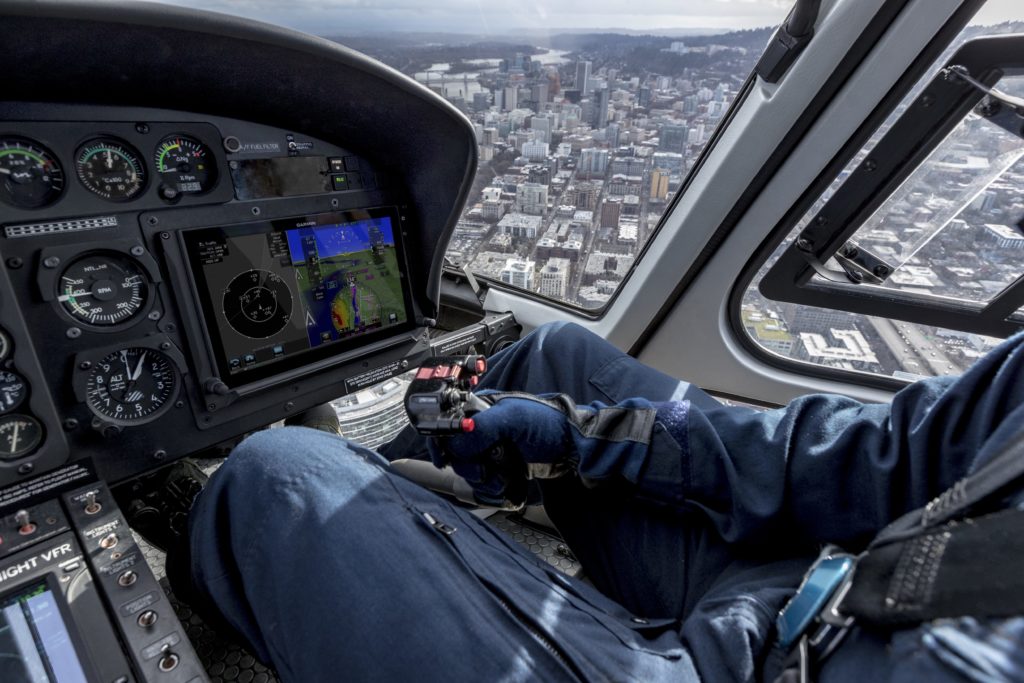
The helicopter crash that killed basketball legend Kobe Bryant was caused by the pilot’s flight into clouds and ensuing spatial disorientation, the National Transportation Safety Board (NTSB) ruled Tuesday, recommending that the industry study which simulation technologies are most effective in helping pilots recognize the onset of the deadly phenomenon.
In a public meeting conducted virtually due to Covid-19, board members determined that the probable cause of last year’s crash involving an Island Express Helicopters Sikorsky S-76B was pilot Ara Zobayan’s “decision to continue flight under visual flight rules [VFR] into instrument meteorological conditions [IMC], which resulted in the pilot’s spatial disorientation and loss of control.”
Contributing to the accident, according to the NTSB, was “the pilot’s likely self-induced pressure and the pilot’s plan continuation bias, which adversely affected his decision making,” and Island Express’s “inadequate review and oversight of its safety management processes.”
All nine people on board the S-76B, including Bryant and his 13-year-old daughter, Gianna, were killed when the aircraft slammed into a hillside in Calabasas, California, on Jan. 26, 2020. They had been traveling across the Los Angeles metropolitan area from Orange County to the Camarillo Airport, taking an indirect route to avoid fog and low clouds.
Just before the crash, Zobayan told air traffic control that he was climbing to 4,000 feet, which would have taken him through a widespread cloud layer — illegally, for his VFR operation. Radar data indicated that the helicopter reached 2,300 feet mean sea level, just 100 feet below the top of the cloud layer, before entering a descending left turn and ultimately impacting terrain.
According to NTSB staff, Zobayan likely experienced two powerful illusions associated with his vestibular system: “the leans,” making him think he was flying straight and level while actually in a turn, and a somatogravic illusion that gave him the impression the helicopter was climbing when in fact it was descending.
“There’s really two types of disorientation,” explained NTSB Chairman Robert Sumwalt during the meeting. “There’s the type of disorientation like you’re lost — you might think you’re over the I-5 freeway, but you’re really over the 101. And that’s not the type of disorientation that we’re talking about here at all. We’re talking about spatial disorientation, where literally the pilot may not know which way is up or down, whether he or she is leaning left or right.”
In such a loss of control situation, a helicopter terrain awareness and warning system (HTAWS) would not have aided the pilot, Sumwalt said. HTAWS is one of the technologies that would be required for turbine-powered rotorcraft with six or more passenger seats under a proposed Kobe Bryant & Gianna Bryant Helicopter Safety Act, which also calls for such helicopters to be equipped with a flight data recorder (FDR) and cockpit voice recorder (CVR).
“[HTAWS] devices are designed for a class of accidents we call CFIT or controlled flight into terrain, in which the aircraft [is] under control of the pilot,” said investigator in charge Bill English. “This accident is not consistent with a controlled flight into terrain scenario.”
For most of the accident flight, English continued, Zobayan was well aware of the surrounding terrain, while in the final seconds of the accident flight, HTAWS would likely have been “more of a confusing factor than anything else. So while it’s great technology, we just don’t think it applies here,” he said.

Instead, the NTSB is recommending to the Federal Aviation Administration (FAA) that it require Part 135 operators such as Island Express to use appropriate simulation devices to provide pilots with relevant scenario-based training. Such training would address “the decision-making, skills, and procedures needed to recognize and respond to changing weather conditions in flight, identify and apply mitigation strategies for avoiding adverse weather, practice the transition to the use of flight instruments to reduce the risk of spatial disorientation, and maintain awareness of a variety of influences that can adversely affect pilot decision-making.”
Recognizing that some simulation devices may not adequately prepare pilots for the reality of spatial disorientation, the NTSB also wants the FAA to “convene a multidisciplinary panel of aircraft performance, human factors, and aircraft operations specialists to evaluate spatial disorientation simulation technologies to determine which applications are most effective for training pilots to recognize the onset of spatial disorientation and successfully mitigate it, and make public a report on the committee’s findings.”
Not the first time?
In choosing to continue VFR flight into IMC — a not uncommon occurrence — Sumwalt suggested that Zobayan fell prey to what he colloquially called “SLOJ: sudden loss of judgment.”
“Basically the scenario that we believe happened is that he’s flying along, he realizes that he’s sort of getting boxed in with visibility. And then he must have made the decision, ‘You know what, I’m just going to punch up through these clouds and get on top,’” Sumwalt said.
Although it was not mentioned in the public meeting, at least one of the pilots who worked with Zobayan told the NTSB that Zobayan claimed to have taken similar risks in the past. Another pilot told investigators that multiple pilots at Island Express were rumored to have occasionally punched through cloud layers to accomplish their flights.
Perhaps a result, the NTSB reiterated a previous recommendation that the FAA require all Part 135 operators “to establish a structured flight data monitoring program that reviews all available data sources to identify deviations from established norms and procedures and other potential safety issues.” Additionally, the agency wants all turbine-powered, non-experimental, non-restricted-category aircraft that are not equipped with an FDR or CVR to be retrofitted with a crash-resistant flight recorder system.
The NTSB also reiterated its longstanding recommendation that all Part 135 operators be required to establish safety management system (SMS) programs, even though Island Express had a voluntary SMS that was, by numerous accounts, ineffective. For example, a 2019 audit by one customer, Chevron, had multiple findings related to Island Express’s SMS, including the lack of proactive hazard analysis and the fact that the safety manager had received no formal SMS training.
The NTSB contends that a mandatory SMS would include an oversight component that would increase its effectiveness. “Although the company had an SMS, our investigations show that they did not effectively develop and implement the entire program,” Sumwalt said.
Despite these deficiencies, NTSB board members and staff reiterated multiple times that they did not believe Island Express to be “uniquely unsafe.”
“I think we see crashes with other carriers that don’t particularly indicate that they are unsafe but they’ve had a gap; they’ve had a flaw,” English said. “Perhaps they didn’t know any better, but that doesn’t necessarily make them a problem operator. They just need to do some things differently.”



